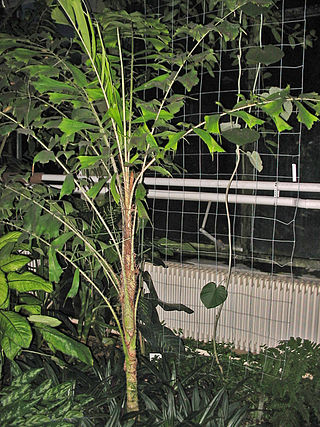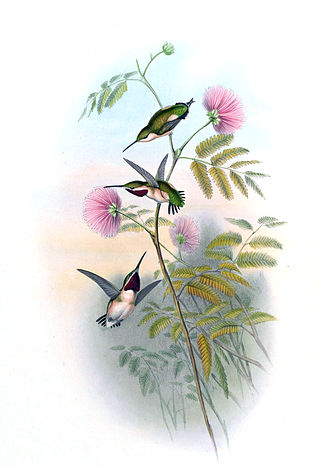
The vicuña or vicuna is one of the two wild South American camelids, which live in the high alpine areas of the Andes, the other being the guanaco, which lives at lower elevations. Vicuñas are relatives of the llama, and are now believed to be the wild ancestor of domesticated alpacas, which are raised for their coats. Vicuñas produce small amounts of extremely fine wool, which is very expensive because the animal can only be shorn every three years and has to be caught from the wild. When knitted together, the product of the vicuña's wool is very soft and warm. The Inca valued vicuñas highly for their wool, and it was against the law for anyone but royalty to wear vicuña garments; today, the vicuña is the national animal of Peru and appears on the Peruvian coat of arms.

Aiphanes is a genus of spiny palms which is native to tropical regions of South and Central America and the Caribbean. There are about 26 species in the genus, ranging in size from understorey shrubs with subterranean stems to subcanopy trees as tall as 20 metres (66 ft). Most have pinnately compound leaves ; one species has entire leaves. Stems, leaves and sometimes even the fruit are covered with spines. Plants flower repeatedly over the course of their lifespan and have separate male and female flowers, although these are borne together on the same inflorescence. Although records of pollinators are limited, most species appear to be pollinated by insects. The fruit are eaten by several birds and mammals, including at least two species of amazon parrots.

The short-tailed woodstar is a species of hummingbird in tribe Mellisugini of subfamily Trochilinae, the "bee hummingbirds". It is the only species placed in the genus Myrmia. It is found in Ecuador and Peru.

Coptodera is a genus of beetles in the family Carabidae, constituted of 105 species distributed across North and South America, Africa, Oceania and eastern Asia.

Calosoma retusum is a beetle of the family Carabidae.
Calosoma atrovirens is a species of ground beetle in the subfamily of Carabinae. It was described by Maximilien Chaudoir in 1869.
Calosoma bridgesi is a brachypterous species of ground beetle in the subfamily of Carabinae. The species is 18–20 millimetres (0.71–0.79 in), is reddish-black coloured, and is endemic to the Andes mountains of Bolivia, Argentina, and Chile where it is found on elevation of 3,500 metres (11,500 ft). It flies in January and February.
Calosoma cicatricosum is a species of ground beetle in the subfamily of Carabinae. It was described by Maximilien Chaudoir in 1869.
Calosoma costipenne is a species of ground beetle in the subfamily of Carabinae. It was described by Maximilien Chaudoir in 1869.
Calosoma depressicolle is a species of ground beetle in the family Carabidae. It is found in Mexico.
Calosoma ewersmanni is a species of ground beetle in the family Carabidae. It is found in Turkey.
Calosoma fulgens is a species of ground beetle in the subfamily of Carabinae. It was described by Maximilien Chaudoir in 1869.
Calosoma laevigatum is a species of ground beetle in the subfamily of Carabinae. It was described by Maximilien Chaudoir in 1869.
Calosoma lugens is a species of ground beetle in the subfamily of Carabinae. It was described by Maximilien Chaudoir in 1869.

Calosoma planicolle is a species of ground beetle in the subfamily of Carabinae. It was described by Chaudoir in 1869.
Calosoma politum is a species of ground beetle in the family Carabidae. It is found in Mexico.
Calosoma striatipenne is a species of ground beetle in the subfamily of Carabinae. It was described by Maximilien Chaudoir in 1869.
Calosoma subaeneum is a species of ground beetle in the subfamily of Carabinae. It was described by Maximilien Chaudoir in 1869.
Calosoma trapezipenne is a species of ground beetle in the subfamily of Carabinae. It was described by Maximilien Chaudoir in 1869.





